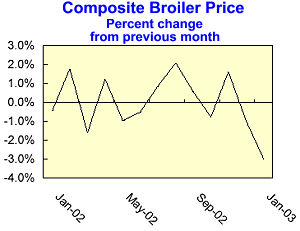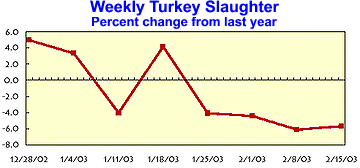



Poultry Outlook Report - February 2003
By U.S.D.A., Economic Research Service - This article is an extract from the February 2003: Livestock, Dairy and Poultry Outlook Report, highlighting Global Poultry Industry data. Poultry prices are expected to rise in 2003 as total red meat and poultry production drops 1-2 percent from last year.| Overview |

Broiler production in 2003 is expected to be up less than 1 percent from last year. The weekly
egg sets are below a year ago as producers react to low prices and export uncertainties.
The timing of Russia’s poultry quota remains unclear, but the U.S. share of the quota is expected to be large enough to allow a 5-percent increase in total broiler exports in 2003. As a result, broiler prices are expected to average 60 cents per pound in 2003, compared with 55.6 cents last year.
| Trade and Disease Issues Dominate Poultry Industry |
There are currently a number of trade and disease issues affecting the U.S. poultry industry. How these issues are resolved could have an impact on both short-term and long-term outlooks especially regarding poultry shipments to Russia, China, and Mexico, the three largest U.S. poultry export markets.
- Russia has indicated that it will place a quota on total poultry imports starting around May 1, 2003. The quota is expected to be 744,000 metric tons, with 553,500 metric tons allocated to the United States. Over the 8-month period of the quota this would average out to 152.5 million pounds a month, almost 20 million pounds above average U.S. poultry shipments to Russia during the first 11 months of 2002. However, this is almost 40 million pounds a month less than in 2001, when the U.S. shipped a record 2.3 billion pounds of broiler products to Russia, 192 million pounds a month. In 2004, the overall Russian import quota will be approximately 1 million metric tons. If the U.S. receives the same percentage of the quota as in 2003, then U.S. exports to Russia would be around 780,000 metric tons, or 143 million pounds per month. The stated purposes of the quota are to protect Russia’s domestic poultry industry and to encourage its expansion. The quotas are for all poultry product imports, so shipments of turkey products would also count as part of the quota.
- Russia is also in the process of certifying which U.S. poultry processing plants will be
allowed to continue to export there. At some point, broiler products from plants without this
certification will be disallowed. To date, only a small number of U.S. plants have passed this
certification process.
- As of January 1, 2003, under the North American Free Trade Agreement (NAFTA), all quotas and tariffs on U.S. poultry products exported to Mexico were phased out. However, Mexico has placed a tariff-rate quota (TRQ) on the importation of U.S. broiler leg quarters, thighs, and drumsticks. Imports over the quota will incur a 98.8-percent tariff. Presently, the TRQ is for 6 largest U.S. export market, have not been affected and will have no quotas or tariffs.
- Currently, there are ongoing discussions with the Chinese government regarding changes in poultry labeling requirements. China insists on bilingual labels directly on shipping containers and on plastic inner liners. China has placed a deadline of April 1, 2003, on this new requirement, after which shipments without the correct labeling will be refused entry.
- Exotic Newcastle disease (END) has been detected in Southern California and parts of Nevada and Arizona. END does not affect humans, but is highly contagious and deadly among poultry. So far, the disease has been confined to non-commercial flocks in Nevada and Arizona. In Southern California, commercial egg-laying flocks have been affected and over 2 million birds (less than 1 percent of the total U.S. domestic egg-laying flock) have been destroyed.
- As a result of the END outbreak, many countries have banned poultry and egg product imports from the affected States. A number of States have also placed restrictions on shipments of live birds, including game birds and pet birds, from the affected areas.
| Broiler Production Expected Lower in First-Half 2003 |
 The low prices and uncertain export environment that prevailed for broilers during much of 2002 has continued into 2003. Broiler production for the first half of 2003 is expected to be down slightly from a year earlier as producers react to low prices and export uncertainties. This is the first time that federally inspected broiler production has fallen in two consecutive quarters since 1975.
The low prices and uncertain export environment that prevailed for broilers during much of 2002 has continued into 2003. Broiler production for the first half of 2003 is expected to be down slightly from a year earlier as producers react to low prices and export uncertainties. This is the first time that federally inspected broiler production has fallen in two consecutive quarters since 1975.
The expectation is that smaller production will eventually reduce the large supplies of frozen broiler products currently overhanging the market, and unless further trade issues develop, exports in 2003 are expected to exceed those of 2002. The combination of lower broiler production and improving trade, along with lower competing meat supplies, are expected to gradually strengthen broiler prices in the second half of 2003. By the second half, production is expected to be increasing, rising 3.3 percent in the fourth quarter compared with the previous year.
U.S. broiler meat production for 2002 on a ready-to- cook (RTC) basis was 32.3 billion pounds, 3.3 percent higher than in 2001. The increase in production was due to a 1.6-percent increase in the number of birds being slaughtered and a 1.4- percent increase in the average weight of broilers at slaughter. During the fourth quarter of 2002, broiler integrators slowed production in response to low prices in the domestic market and low prices for exported products due to uncertain access to the Russian market, by far the largest for the U.S.
During the fourth quarter of 2002, production was 7.94 billion pounds, only 1 percent above the same period in 2001. The number of birds processed in the fourth quarter actually was down 0.2 percent, and only an increase of 1.6 percent in average slaughter weights pushed broiler production higher.

| Turkey Production Seen as Flat in 2003 |
 Turkey production in 2003 is forecast at 5.7 billion pounds, up only marginally from the previous year. With large stocks of turkey products at the beginning of the year and no growth expected in domestic per capita consumption or exports, turkey prices are expected to be relatively flat in 2003, especially for turkey parts.
Turkey production in 2003 is forecast at 5.7 billion pounds, up only marginally from the previous year. With large stocks of turkey products at the beginning of the year and no growth expected in domestic per capita consumption or exports, turkey prices are expected to be relatively flat in 2003, especially for turkey parts.
Turkey production in 2002 paralleled broiler production. RTC production totaled 5.7 billion pounds, up 2.8 percent from the previous year. Like broilers, turkey production slowed in the
second half, with production only 1.3 percent higher than the previous year (as opposed to
4.4 percent higher in the first half of the year).
An outbreak of avian influenza in some turkey production areas earlier last year was originally expected to increase prices, but the number of birds affected was too small to effect prices on a national level. Prices for whole birds in 2002 averaged 64.5 cents per pound, down 2.8 percent from the previous year. Prices for turkey parts were also lower, with prices for turkey breasts down 4.1 percent and wing prices 25 percent lower.

| Little Growth Expected in Egg Production |
Egg production for consumption and for hatching is expected to be basically flat in 2003. This
slowdown in the availability of eggs for consumption is expected to result in higher wholesale prices. Two major issues are expected to affect the demand for eggs.
First, a slower economy is expected to lower the demand for breaking eggs, which has been a growing component of table egg demand. Second, U.S. exports of eggs in 2003 are forecast to be only 77 percent of what they were 5 years earlier as domestic production rises in other countries. This reduction in exports has left more eggs for consumption in the domestic market.
Egg production in 2002 was 7.22 billion dozen, with 85 percent of that coming from table egg production and the remainder from hatching egg production. Hatching egg production was down slightly from the previous year, mostly due to the slowdown in broiler industry growth. Production of eggs for consumption was also relatively flat, increasing only 1.1 percent. One growth area in the egg industry was in the number of eggs broken for restaurant and bakery use. Breaking egg use in 2002 totaled 1.9 billion dozen, or 31 percent of total egg consumption.
| Further information |
Links
For more information view the full Livestock, Dairy and Poultry Outlook - February 2003 (pdf)Source: Livestock, Dairy and Poultry Outlook - U.S. Department of Agriculture, Economic Research Service - February, 2003








